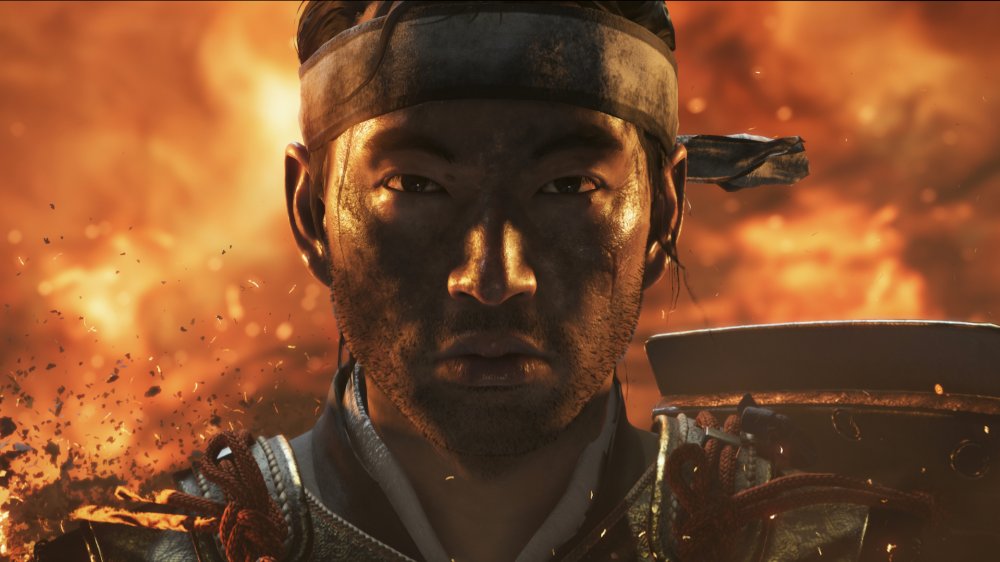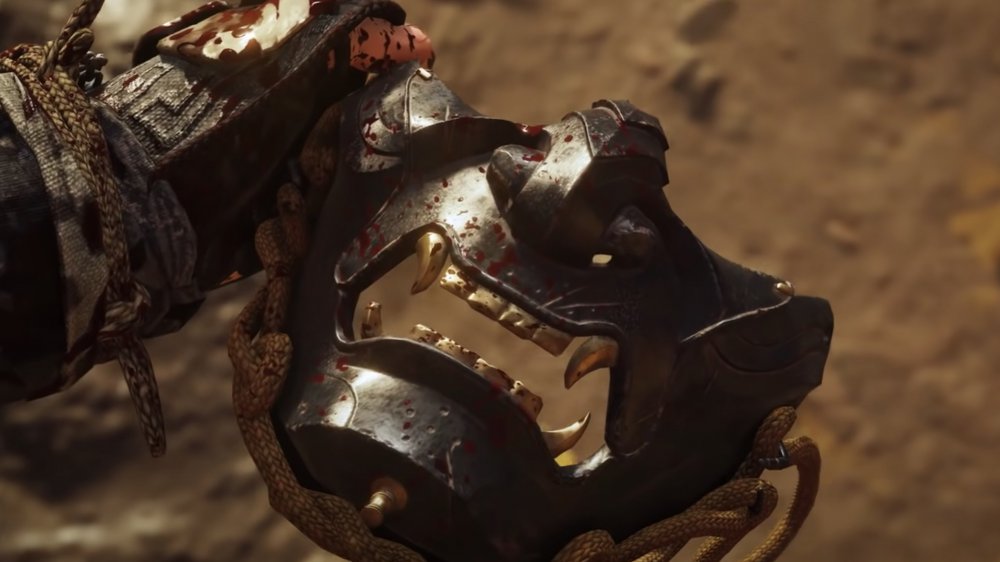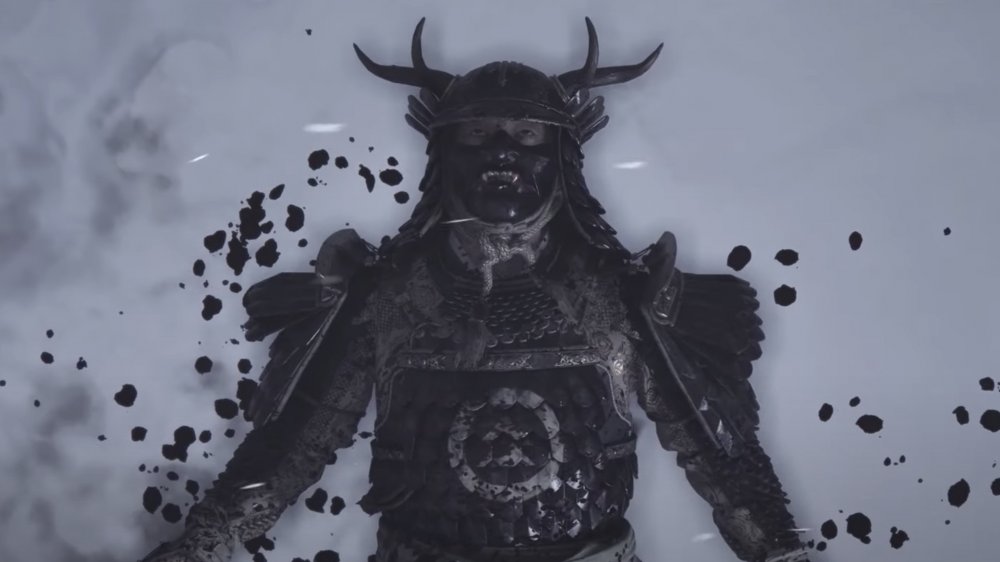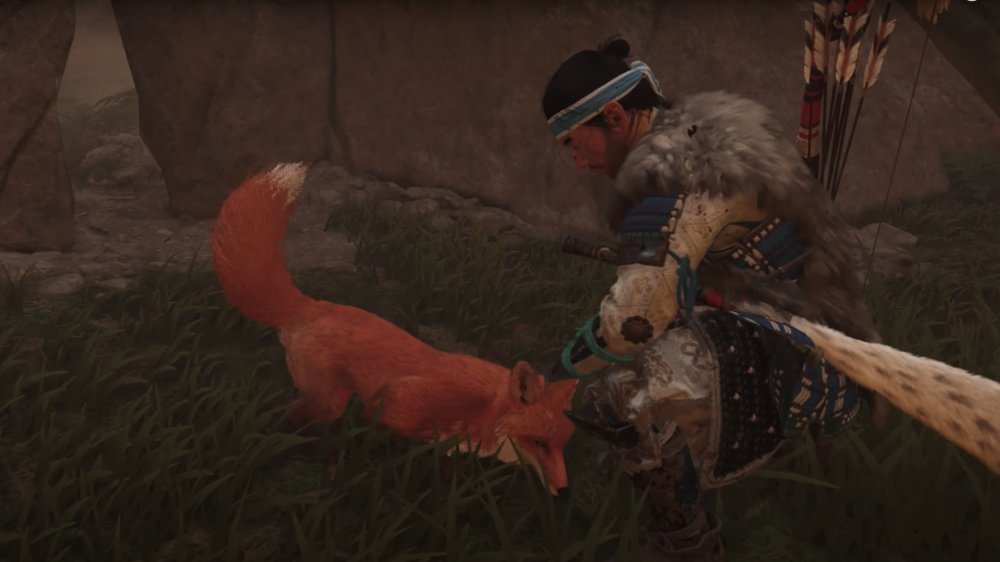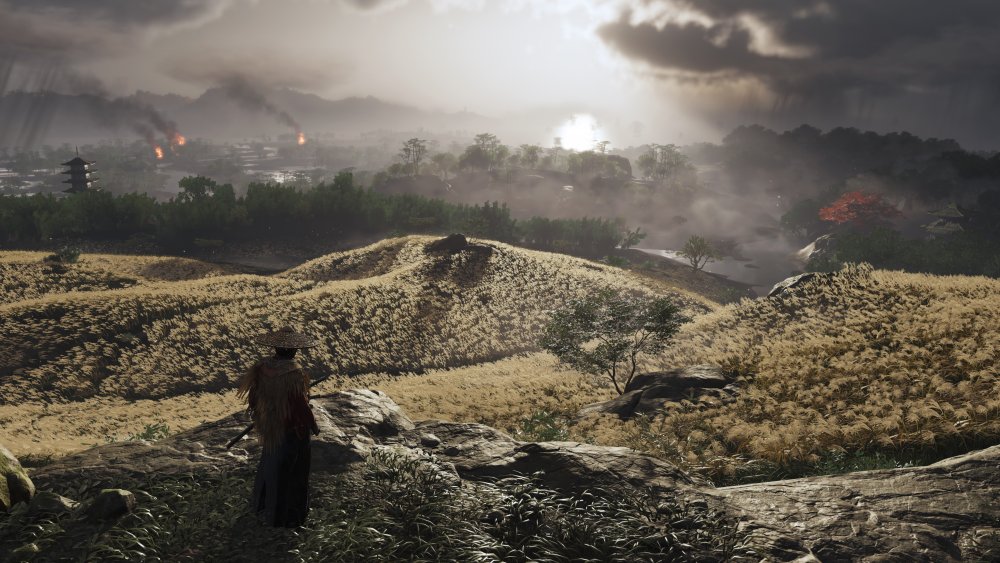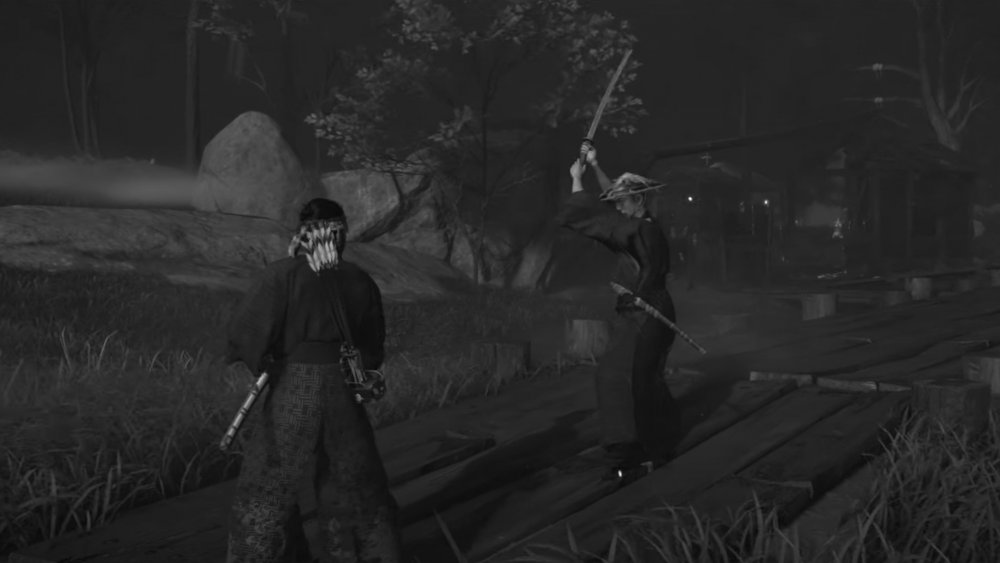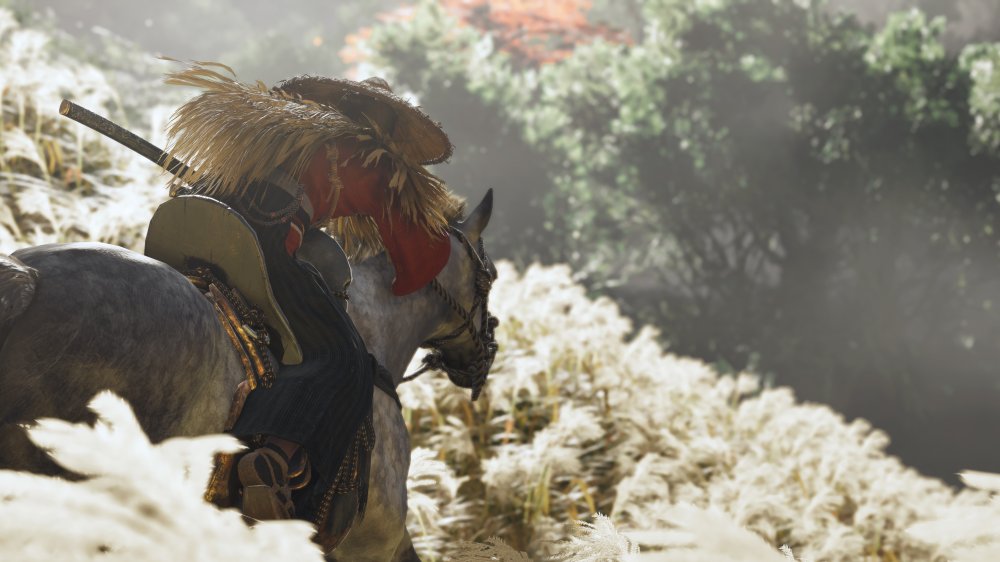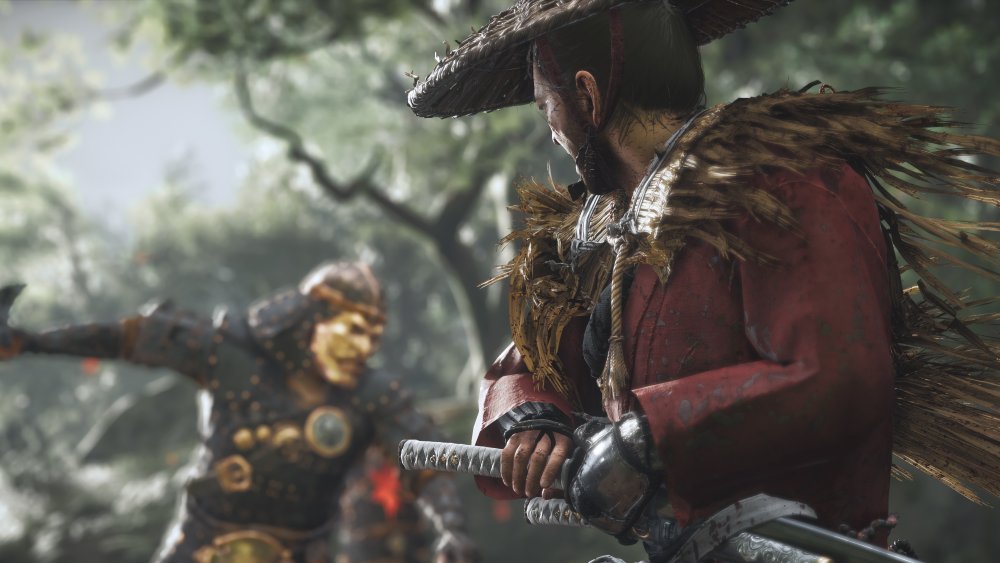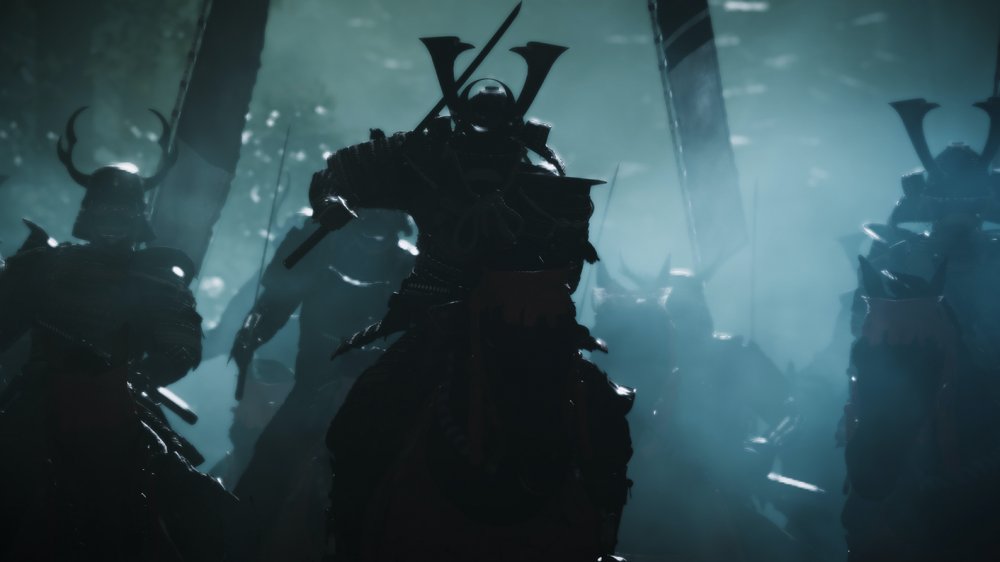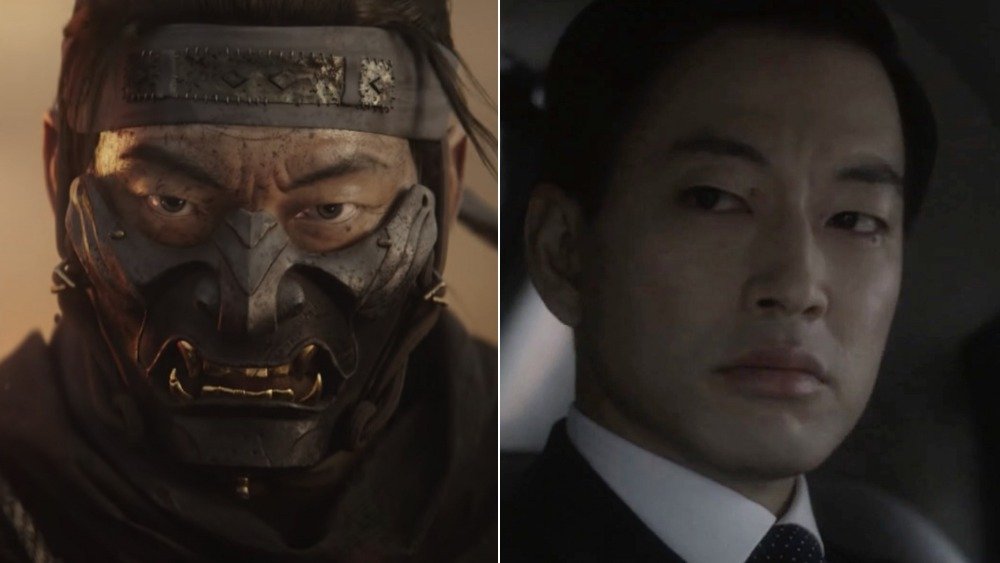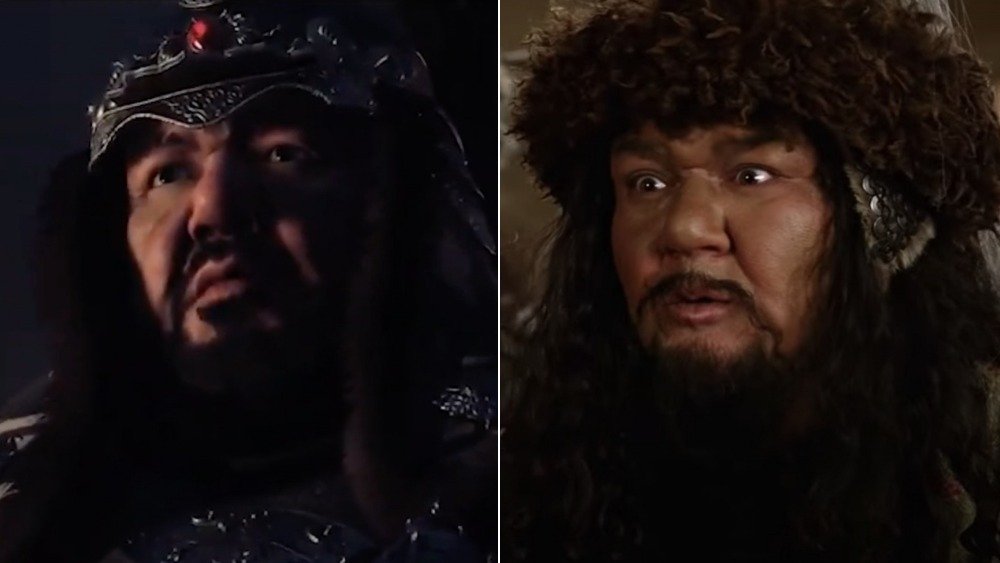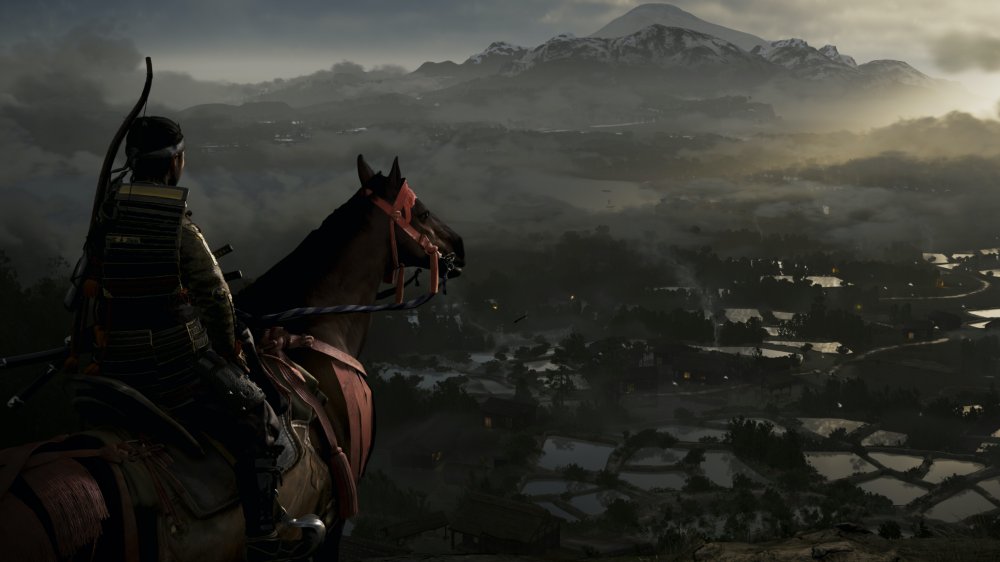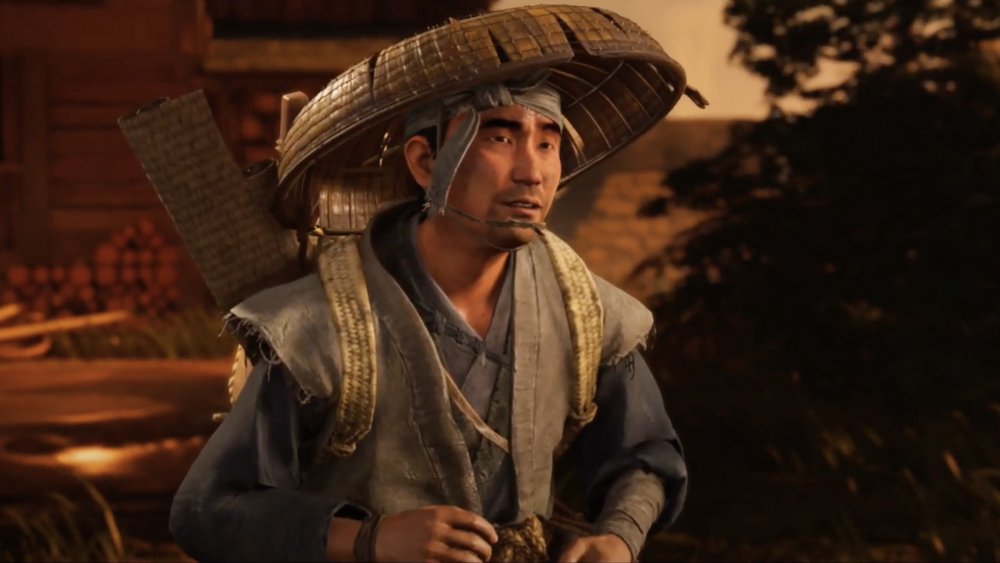Things Only Adults Notice In Ghost Of Tsushima
PlayStation 4's Ghost of Tsushima is an open-world tour de force through a beautiful, 13th century Japanese island stained red with the blood of its people. If hero Jin Sakai has anything to say about it, then it'll be stained with the blood of the savage Mongol invaders, too. Both meditative and strewn with charred corpses, Sucker Punch's 2020 samurai masterpiece isn't exactly the most kid-friendly outing. That said, if you're the kind of aging gamer who was raised by the likes of Liu Kang and co., then you're probably just fine with your youngest diving blade-first into the Mongol horde.
But guts, gore, and corpses galore aren't the only things keeping Ghost of Tsushima firmly on the adult end of the gaming spectrum. There are some big, uncomfortable concepts fluttering through the Tsushima winds. Here are the things that only adults notice in Ghost of Tsushima.
The meaning behind the masks
Like many open-world action-adventure titles, Ghost of Tsushima is chock-full of customization options — both practical and purely cosmetic. From the color of Jin's armor to the style of his trusty sword, Ghost provides plenty of ways to kick invader butt in style. One of the most intriguing and personalizable parts of Jin's armor is his selection of masks.
From thief-like wraps to full ornate face coverings, these masks are little more than accessories meant to further immerse players in Ghost of Tsushima's samurai fantasy — at least, that's the purpose they serve in-game. While they may appear bizarre and even creepy to younger gamers, adult gamers may realize that they're actually rooted in real samurai history.
Their purpose was two-fold. According to Japanese tourism website Maikoya, they're called Men Yoroi (or "Menpou") — literally, "face armor." Their appearance was meant to both protect a samurai's face from enemy weapons and frighten those same enemies on the battlefield, hence the emphasis on a "war-like" visage. Could you imagine charging at a far-off army only to come face-to-face with throngs of this? Yikes!
The wind at your back, the birds in the trees
Ghost of Tsushima's titular island is teeming with nature, featuring lush landscapes, raging water, and even vicious predators, and the game takes full advantage of it. Case in point: its use of various animals and natural elements to guide Jin from point A to point B. Following golden birds leads Jin to any number of side activities while the guiding wind, on the other hand, guides the samurai to waypoints players can select on their in-game map. Both of these probably come off as little more than game mechanics to most players, but older gamers may pick up on the role they play in the game's narrative.
During an early flashback in which Jin recalls the death of his father, an elderly woman tells a younger Jin that he's not alone, as his father is "the wind at [his] back," while his mother is "the birds in the trees."
While this is nothing more than a bit of foreshadowing, young gamers who haven't studied such literary devices might miss out on the nifty little line.
What does the fox say?
Not all animals in Ghost of Tsushima guide you to nifty loot, lush landscapes, and hot springs. In fact, some — like the game's wild boars and vicious bears — would like nothing more than to tear you apart and dig into some good, old-fashioned samurai sashimi. Luckily for players, the foxes that populate the game's island are not the bite-y, rip-y, tear-y variety.
In Ghost of Tsushima, foxes act as guides, leading hero Jin to Inari shrines which he can "honor" in exchange for more charm slots or a boost in potency for the ones he's already got. And while their role in Ghost of Tsushima is to act as the fuzziest navigators and get all of the pets, their role in ancient Japanese mythology is even more interesting, though younger gamers likely wouldn't really do the digging needed to know why.
According to Encyclopedia Britannica, foxes are sometimes identified as messengers of the god Inari, an ancient Japanese deity associated with prosperity, swordsmiths, brothels, entertainment, and rice cultivation. Additionally, foxes are represented in Japanese mythology as both benevolent and malevolent, mirroring hero Jin Sakai's ability to balance both compassion and brutality.
Tsushima is an inspired open island
A sprawling, open-world epic like Ghost of Tsushima lives and dies by its setting — and the namesake island of Sucker Punch's samurai opus is certainly a triumph. But while riding your trusty steed through the pampas grass might feel refreshing, it also might feel a bit familiar. At least, to gamers old enough to enjoy Rockstar Games' mature titles, that is.
Sucker Punch took inspiration from a variety of similarly open-world adventure games. Talking to GAMINGbible, Ghost of Tsushima game director Nate Fox revealed how his team was influenced by the way that Rockstar's Red Dead Redemption made you feel like a real outlaw. "Landscape, the way that people talk to you, the way that you move — all have it brought you into that identity," Fox said.
He also explained how moved he was by The Legend of Zelda: Breath of the Wild and its ability to "[show] how the power of curiosity can be stoked in all these many ways." He added, "That game really inspired us to try even harder, to go deeper, to just clear out the decks so that you could be just as present as possible in Tsushima."
Kurosawa Mode pays homage
One of the most unique aspects of Ghost of Tsushima is its art direction, helmed by Sucker Punch's James Connell. Let's be real: There's nothing quite like watching your blade cut through a bandit's body like a hot knife through butter.
But if you really want to get the most cinematic bang for your yen, then it's Kurosawa mode or bust. This grainy, dusty, black and white filter recalls your granddad's favorite old-school samurai flicks. It even changes the audio quality with some help from Sucker Punch's audio team. According to an interview with Entertainment Weekly, the team took advantage of "an internal tool that mimicked sounds of old TV and, specifically, megaphones, radios, TVs back to the '50s."
Sorry, young gamers: Kurosawa mode isn't named after some legendary samurai or shogun supreme — but its namesake does boast a special relationship with samurai. The late filmmaker Akira Kurosawa was a widely celebrated auteur best known for directing samurai flicks like Seven Samurai, Yojimbo, and Sanjuro. Ironically, early Japanese critics found the legendary director's movies to have a Western feel, and his style was often compared to the American cowboy movies from which some of his films took inspiration.
DualShock to your system
Unpopular opinion: Despite how frickin' rad the PlayStation 4's controller is, not enough games took advantage of the DualShock 4's hardware. Sure, you've got Death Stranding's rock-the-baby simulator. And yeah, Sucker Punch's very own inFAMOUS Second Son boasted that whole "DNA scanner" touchpad nonsense. But there's a whole lot of tech inside of the DualShock 4 that the majority of devs straight-up ignore. And that's a shame.
Ghost of Tsushima, however — like Sucker Punch's inFAMOUS Second Son — takes full advantage of said technology. Swiping the DualShock 4 touchpad in any given direction performs an action respective to said direction: Up summons the guiding winds and down allows Jin to show respect by bowing. Meanwhile, swiping left breaks out our hero's dope-as-heck flute, while right controls Jin's sword, both sheathing it and unsheathing it as needed.
And if you say you ever get tired of hearing Ghost of Tsushima's majestic wind bellowing from your DualShock 4 speaker, you're lying.
Younger players might take this kind of tech for granted, but, for older gamers who entered the fray mashing those NES buttons on that chocolate bar of a controller? This is the future.
No wrong way to slay
Remember karma meters? That whole good/bad, hero/antihero dichotomy popularized by games like Fallout 3 and the inFAMOUS franchise? Well, you don't have to remember that far back, because they've been employed as a mechanic in games as big as — and as recent as — 2018's Red Dead Redemption 2. Though a few games have implemented karma systems in interesting ways, one might argue they're just plain morally restrictive — and, in turn, restrictive to gameplay. Welp, Sucker Punch seems to agree.
Hence, they deliberately left such a meter out of Ghost of Tsushima, opting, instead, to allow players to samurai — or samur-nay — as they wish. Lord Shimura might not be a huge fan of the comparatively stealthier Ghost techniques that Jin learns throughout his journey across Tsushima, but players are free to switch between traditional samurai tactics and their sneakier alternative on the fly.
The whole "no right or wrong way to play" philosophy might go over the heads of younger gamers, who may not be familiar with the moral gray area of war. But for adults who are finally free to liberate their homeland as they see fit, it's a breath of fresh air.
West meets East
From Team Ninja's yokai slaughter-fest 2K19 — a.k.a. Nioh 2 — to FromSoftware's Sekiro: Shadows Die Twice (and then like 300 more times), Japan is responsible for some killer samurai games. But contrary to its unapologetically Japanese vibe, Ghost of Tsushima is not one of them. Youngins unfamiliar with game developers might not be aware of this, but Sucker Punch is an American studio stationed in Bellevue, Wash. The studio's previous game — 2014's inFAMOUS Second Son — even took place in a scaled-down version of the state's largest city, Seattle.
There are few aspects of Ghost of Tsushima that give away its Western origins, but if you want to see an example that's both fascinating and surreal as heck, switch the audio language from its default English to Japanese. Then sit back, relax, and watch as Jin and company straight-up continue to move their mouths as if speaking English. Adults growing up with those old, poorly dubbed Godzilla movies will feel right at home with the kaiju-sized cognitive dissonance. This is just like that — only the exact opposite.
IRL Jin is an Sony alum
The concept of motion capture in video games is really nothing new. In fact, as far back as 1994, titles like Yu Suzuki's Virtual Fighter 2 were sticking ping pong balls on leotard-clad actors and capturing their performances — or whatever the early '90s version of the process was like.
A whole lot of games have been utilizing motion capture technology — or "mo-cap" — for a long dang time. So, it should come as no surprise that Sucker Punch put said technology into play in order to make Jin Sakai as realistic a hero as possible.
Mature Amazon Prime users might recognize the man behind Jin's menpou as Daisuke Tsuji, the Kuwait-born Japanese-American actor who portrays the Crown Prince of Japan in the super-not-for-kids alternate history drama The Man in the High Castle. And while the role of Jin Sakai is Tsuji's first motion capture role for a video game, he's lent his talents to a Sony Interactive Entertainment-published title before, though in a much smaller capacity. He voiced a character named The Musician in Kojima Productions' Death Stranding, though he didn't lend his likeness to the NPC.
Khotun Khan spent a Night at the Museum
While the real-life Jin Sakai has a handful of acting credits to his name, the actor who lends his talents to the Ghost's nemesis — the brutal Khotun Khan — is as seasoned as his performance as the Mongol warlord is spine-chilling. From the supernatural comedy-drama iZombie to the teeth-achingly upbeat Glee, Canadian actor Patrick Ghallagher has done it all. That said, there's one particular role that just may have prepared him to leap into the boots of the vicious Khotun Khan.
Young gamers might not realize this, but Ghallagher has portrayed another brutal nomadic leader before — just, y'know, in a fantasy-comedy rather than a historical action game. In 2006's Night at the Museum — and in both of its sequels, Battle of the Smithsonian and Secret of the Tomb — Ghallagher played Atila the Hun, a role that he reprised for the 2009 video game adaptation of Battle of the Smithsonian for the Nintendo Wii.
So if you ever find yourself flipping through the channels and landing on this scene — and your partner pokes you and says, "It's that guy! From that thing!" — you'll know who they're talking about. Khotun Khan from Ghost of Tsushima, obviously.
The haiku problem
In Ghost of Tsushima, samurai extraordinaire Jin Sakai spends a lot of time killing a lot of dudes. But every so often, when he's not killing said dudes, he's also taking time to reflect on his place in the world. These periods of respite take the form of visits to areas where the hero of Tsushima can record his thoughts as impromptu haikus. There's just one problem.
Ghost of Tsushima gets the concept of haiku almost completely wrong. Kotaku's Ian Walker wanted to test this hypothesis, so he sent one of his Ghost-generated haiku to founder and director of The Haiku Foundation Jim Kacian. The haiku expert was not impressed. In an email, he cited myriad problems with the game's take on the poetry genre ranging from claims that the language was too metaphorical to issues with its over-reliance on the 5-7-5 syllable formula.
He went on to tell Walker, "I hope I'm not hurting your feelings here, but none of these are even close to competent haiku, if you are interested in the history and value of the genre."
The kiddos might not care about flowery poems, but for grown-up gamers grasping for an authentic peek at a samurai's soft spot, that's a real ouch.
For sake's sake
Ghost of Tsushima gets a lot of things right about 13th century Japan. The Mongols really did invade the Japanese island of Tsushima in the 1200s. Likewise, small groups of loyal samurai did fight back against the hordes — though there was little they could do in the early stages of the conflict, as their weapons and numbers were far inferior to those of the invaders.
While much of the game is deeply rooted in a sense of realism and historical accuracy, older gamers — especially those familiar with history and specifically those with an affinity for adult beverages — might notice anachronisms in the game's depiction of 13th century Japan.
According to Kotaku's Brian Ashcraft — a self-proclaimed sake nerd and author of The Japanese Sake Bible — Tsushima's take on sake brewing is pretty shaky. Ashcraft explained that earthenware urns were used to store the spirit as opposed to the game's large wooden tubs. He also takes issue with the fact that a common brewing technique involving heavy rocks applying pressure to unpressed sake in the game wasn't actually invented until the 1600s — over 400 years after the events of Ghost.

